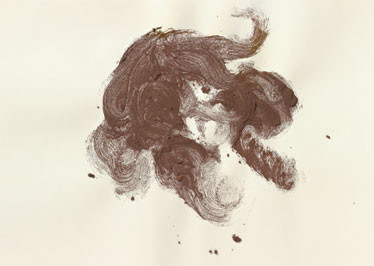Daniel Lergon
16 Mar - 07 May 2011
DANIEL LERGON
3000K
16 March - 7 May, 2011
Approximately 400,000 years after the Big Bang light and matter secede. The basis for human existence is created – as is he basis for painting: colour. Without any pathos, which one could presume due to the significance of this moment within the history of Planet Earth, in his artistic analysis Daniel Lergon questions precisely these principles.
The mystery around the „first colours“ is just as unanswerable as it is fascinating, and rips into the heart of painting: How does colour emerge from a co-occurrence of light and surface? Are there colours apart from those we know? Is it possible to paint without colour? The exploration of these questions leads Lergon to the ultimate borders of the colour spectrum. He experiments with different materials, surfaces and light settings. The results are virtually white pictures. Lergon applies transparent coatings on retro-reflexive material, a high-tech product that is used for the production of special apparel. In these „colourless“ paintings light turns into the protagonist. It is refracted on the surface, brings out colours and lets them disappear again. Depending on the observers’ viewpoint the painting changes, appears glossy or matt, glows, reflects and oscillates between flatness and three-dimensionality. The interaction between the immateriality of light and the materiality of the surface is a core issue in Lergon’s painting, just as the processuality with which the picture repeatedly produces itself in new ways.
After „K“ (2007) and „3K“ (2009), „3000K“ is Lergon’s third exhibition title quoting the temperature unit respectively the unit for colour temperature „Kelvin“. Whereas „3K“ represents the current cosmic background radiation, 3000K lies somewhere between the melting point of iron (1808K) and the average temperature on the sun’s surface (5778K). But also in other titles Daniel Lergon alludes to physical and astronomical phenomena. (For instance „Albedo“, 2007, Galerie Andreas Huber. Albedo describes the criterion for a body’s reflectivity.) They are a source of inspiration for the artist, not only with regards to his considerations on the constitution of colour but also for finding form.
3000K
16 March - 7 May, 2011
Approximately 400,000 years after the Big Bang light and matter secede. The basis for human existence is created – as is he basis for painting: colour. Without any pathos, which one could presume due to the significance of this moment within the history of Planet Earth, in his artistic analysis Daniel Lergon questions precisely these principles.
The mystery around the „first colours“ is just as unanswerable as it is fascinating, and rips into the heart of painting: How does colour emerge from a co-occurrence of light and surface? Are there colours apart from those we know? Is it possible to paint without colour? The exploration of these questions leads Lergon to the ultimate borders of the colour spectrum. He experiments with different materials, surfaces and light settings. The results are virtually white pictures. Lergon applies transparent coatings on retro-reflexive material, a high-tech product that is used for the production of special apparel. In these „colourless“ paintings light turns into the protagonist. It is refracted on the surface, brings out colours and lets them disappear again. Depending on the observers’ viewpoint the painting changes, appears glossy or matt, glows, reflects and oscillates between flatness and three-dimensionality. The interaction between the immateriality of light and the materiality of the surface is a core issue in Lergon’s painting, just as the processuality with which the picture repeatedly produces itself in new ways.
After „K“ (2007) and „3K“ (2009), „3000K“ is Lergon’s third exhibition title quoting the temperature unit respectively the unit for colour temperature „Kelvin“. Whereas „3K“ represents the current cosmic background radiation, 3000K lies somewhere between the melting point of iron (1808K) and the average temperature on the sun’s surface (5778K). But also in other titles Daniel Lergon alludes to physical and astronomical phenomena. (For instance „Albedo“, 2007, Galerie Andreas Huber. Albedo describes the criterion for a body’s reflectivity.) They are a source of inspiration for the artist, not only with regards to his considerations on the constitution of colour but also for finding form.

